The automotive industry ushered in a new round of adjustment period, whether mature manufacturers can avoid collective panic
In anticipation of falling sales and hopeless long-term torturous profit, the three giants of Detroit finally touched the bottom line of the business rules. Following last year’s $25 billion government loans fell into the abyss of losses, at the end of August, they and some The parts manufacturer once again applied to the U.S. government for the same amount of secured loans. It can be imagined that in the face of losing face, the Big Three are indifferent to any news that the US market is weak.
But there is a news enough to make them wake up from the state of numbness: In the Chinese market where they have just increased investment, there have been terrible signs of decline. In July 2008, the monthly auto sales in Mainland China increased by only 3.88% year-on-year, which was the lowest point in nearly 40 months, of which the growth rate of passenger cars was only 6.79% year-on-year, and that of commercial vehicles was -3.35% negative growth. A common interpretation in the industry is that the good days for the Chinese auto market that fell in 2006 ended.
Is the industry slump really on schedule? In fact, the sales figures for the first half of 2008 are still encouraging. The cumulative sales of domestic cars totaled 5.17 million, up 17.9% year-on-year. The year-on-year increases in passenger cars and commercial vehicles reached 16.8% and 19.6%, respectively, and the growth rate did decline. Not obvious.
Only relatively lasting happiness will make people so alert to tiny bad news. In fact, over the past two years, automakers have become accustomed to the speeding sensation that sales in China’s auto market have increased by more than 20% year-on-year and profits have grown by more than 50% annually. Once this speed is slightly reduced, inertia will make the driver at a loss.
However, for the many car manufacturers who are working diligently in Risin, this kind of mentality of falling down to midwinter is not entirely unreasonable. Since the beginning of this year, all the tests that the Chinese economy has suffered have left a mark on the auto industry. The natural disasters such as freezing rain, snowstorms in the south, Wenchuan earthquake and so on have prevented a large number of products from being shipped out in time, which has had a significant impact on short-term sales. In addition, the rise in steel prices, high oil prices, the appreciation of the renminbi, and the tightening of credit have brought about a qualitative change in the macroeconomic environment in which the automobile industry is located. In particular, the negative expectations caused by the slowdown in China’s economic growth are causing the automotive industry to lose its past. Brilliance.
At the same time, at the consumer level, the actual demand for car purchases has dropped significantly as SMEs have been in trouble, real estate prices have fallen, and the stock market has fallen.
This is the current reality of China's auto consumption market. In particular, China's own-brand automakers are experiencing multiple difficulties due to declining market demand, the advent of rivals, and cost increases.
The month-on-year growth rate is continuing to decline, automobile sales have become more and more difficult, and the market share of self-owned brands has fallen from 26.28% in 2007 to 25.24%, which clearly indicates that the Chinese auto industry will end its rapid growth in the past two years. Growth, and entering a new round of adjustment period.
Of course, not all auto companies have entered the winter, and Toyota, Honda, Ford and other joint ventures in China have maintained rapid growth in the first half of the year, but this still cannot change the unfavorable expectations of the auto industry. Many analysts predict that the sales growth rate of the Chinese auto industry in 2009 may fall below 10%, so as to reach a true “bottomâ€.
In fact, no matter those auto companies that are in the “winter season†or those that are still in their own hands, they cannot turn a blind eye to this cyclical adjustment caused by the macro economy. Now, they must consider how to spend the winter.
Walking in a hurry
In an industry downturn, corporate turmoil is always frequent. On August 9th, Li Feng, deputy general manager of Chery Automobile and general manager of sales company of China’s own brand leader, left the company for 4 years. In the past four years, relying on Li Feng's integration of sales channels, Chery’s auto sales have grown rapidly from 100,000 units to nearly 400,000 units in 2007, achieving a breakthrough in scale.
Now, it seems like another round of reincarnation. Four years ago coincided with the depression period of China's auto industry, as the Chery Automobile sales of the industry dark horses had a serious crisis, the sales general manager has changed for a few moments and no improvement, Li Feng as the "savior" eventually let Chery's sales system on the right track . Now, Li Feng's departure has given quite a bit of speculation to the outside world. The most widely circulated argument is that Chery's sales have fallen sharply in recent months, and Li Feng has suffered tremendous pressure and left the company. However, the relevant person in charge of Chery’s general manager office denied this claim. “Li Feng's departure is a normal personal career choice, and Chery has no problem at present. In the first half of the year, sales still ranked fourth in the industry.â€
However, it cannot be denied that Chery is one of the companies that has been hit a lot in this round of depression in the auto industry. According to data from the National Passenger Car Information Association, in July 2008, the sales of Chery Automobile fell more seriously, totaling 22,843 units, which was a 40% drop from June sales, and its ranking fell from the third place in June to Seventh in July. In order to cope with this situation, Chery spends heavily on Yang Bo, general manager of Brilliance International, and will be led by Yang Bo in charge of Chery's sales. Yang Bo has held senior positions in major auto companies such as FAW, FAW-Volkswagen, and Jinbei GM, and has extensive marketing management experience.
In addition to accelerating the formation of a new sales team, Chery also made price adjustments to several of its models to stimulate sales. During the Olympic Games, Chery increased its marketing efforts for numerous models. On August 18th, the price of A5, one of Chery’s main models, was reduced by 11,000 yuan. In any case, as the profits of the industry continue to decline, Chery’s pressure on the frontier is growing.
This situation reflects that the auto industry is closely related to the degree of macroeconomic prosperity. At present, the real estate prices have fallen, the stock market has fallen unilaterally, negative wealth effects have become more intense, coupled with the increasingly tense credit situation and the high interest rate of private loans, the enjoyment of residents And the desire to improve consumption is strongly suppressed.
"From the sales of 7-8 months, the sales situation in the second half of the year is definitely not optimistic." A person in charge of a mainstream car manufacturer told "Global Entrepreneur" that the entire automotive industry is now more worried about whether it can complete 1000 this year. With the production and sales of 10,000 cars, the decline in the growth rate of the auto industry is likely to last for a year or so. In 2007, the sales volume of the Chinese auto industry increased by 24%-25%, and in 2008 it remained at 12%-13%, which was a drop of almost half, and the worst in 2009. The result is that the growth rate has fallen below 10%.
Of course, he does not think that the current industry downturn will exceed 2004, and the overall sales of the auto industry are still growing. The most important thing is that the overall trend of cars entering the family will not change, but in the short term, due to the weakening of the macro economy, the development speed may slow down, which will cause pressure and crisis for many auto companies. Now every car company is aware of this, but it is not particularly nervous.
This mentality has a lot to do with the industry’s tragic experience in 2004. At that time, the situation was very similar to the current situation. Sales volume declined, inventory was overstocked, dealers' survival was difficult, and enthusiasm was low. However, today's auto companies have undergone fundamental changes, especially the relative maturity of self-owned brand companies. In such circumstances, they will not be at a loss. Everyone knows that shrinking production, sales, and selling prices, and lowering expectations, will be very effective.
However, whether this type of coping is effective is worth considering. At present, the main cause of poor sales is self-owned brand companies. Toyota, Ford and other multinational companies have maintained rapid growth in their joint ventures in China, indicating that the decline caused by the macro economy is a structural decline. The joint venture products have been adjusted. It has already been relatively competitive in terms of price, and its own brand has still not been able to make major breakthroughs in high-end and high-end products. As a result, it has gradually lost its effective means of competition.
The only thing that is commendable is Geely Automobile. This company has actively stopped production of low-end products. The painful experience of transitioning to the mid-to-high end has won time for itself. In this round of industry adjustment, Geely Automobile is a rare self-owned brand company that has not been greatly affected. Geely's sales in July 2008 increased by 40.5% year-on-year, which is the best off-season month in history.
However, for these "winners", the future is equally difficult. The rise in costs caused by inflation has not been eliminated, and the industry’s profits have been declining. The new round of competition that highlights the encirclement will inevitably lead to a new round of price wars, and the price reduction of cars in the second half of the year will be even more tragic. This will surely come from production. , Procurement, R&D, finance, and many other aspects have changed the auto companies themselves.
For them, the spring may not come until 2010. In this winter, automakers must prepare enough cotton for themselves and maintain their strength for the sprints two years later.
The Single Most Important Thing You Need To Know About Single Sided PCB
As a single sided PCB manufacturer, Jinghongyi PCB has been single sided PCB for many years. Production and manufacturing experience, with a very exquisite single sided PCB manufacturing process flow chart.
We can produce single-sided copper PCB, single sided copper clad PCB board, single sided flex PCB.
We know that when you choose single sided PCB manufacturer, product quality is one of the first factors you need to consider. We are not only engaged in PCB manufacturing for many years, but also one of the large-scale PCB manufacturers in China. We can not only produce single sided PCB, but also double-sided PCB, Multilayer PCB , Aluminum PCB and so on.
In addition to product quality, you may also need to consider the single sided PCB price factor. If you choose us as your partner, you can rest assured that we will be able to provide you with not the best price on the premise of guaranteeing product quality, but the price that we both feel is very reasonable. What do you think?
In this article, we will elaborate on the definition, type, cost components, structure, advantages and disadvantages, manufacturing process and raw materials of single sided PCB. Finally, we will introduce the application of single sided PCB and the differences between single sided PCB and Double Sided PCB. And how to choose between single sided PCB and double sided PCB.
What Is Single Sided PCB
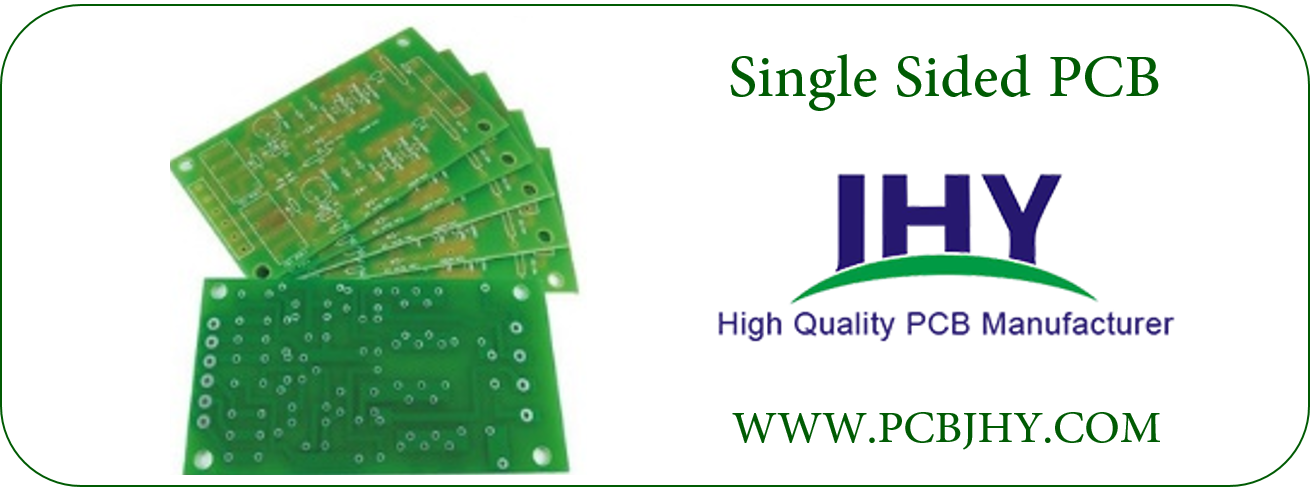
Single-sided PCB diagram mainly used Network Printing(Screen Printing), that is, resist on copper surface, After etching, mark the welding resistance, and then finish the hole and the shape of the part by punching.
Fundamentally, single-sided and double-sided printed circuit boards serve the same purpose. Both serve as catalysts for electrical connections between components, however there are some key differences that set them apart from each other. More specifically, they differ in the costs associated with production and development processes, as well as ampacity differences.
With the appearance of electronic transistor, single sided PCB was developed in the early of 1950, which is mainly manufactured in USA. Single-sided PCB was manufactured by copper etching directly at that time. During 1953 to 1955, Japan use imported copper make out paper phenolic aldehyde copper substrate, and apply mainly on radio products. In 1956, single-sided PCB technology was made big progress with the appearance of professional PCB manufacturers from Japan. In the early stage, copper substrate mainly used paper phenolic aldehyde, but because paper phenolic aldehyde with the factors of low electric insulation, bad solder thermal stability, twist issue etc, paper epoxide resin and glass fiber epoxy resin was developed soon after. Currently, paper epoxide resin is widely used in consuming electronic.
Basically, there is no challenge for PCB manufacturer to produce single sided PCB and the technology is quite mature nowadays. The main focus for PCB manufacturer is how to control production cost and save more cost for customers.
Types of Single Layer PCB
- Single Layer Rigid PCB
It is the type of a single layer PCB which is made up a rigid material such as fiber glass. These PCBs are inflexible and prevent the circuit from bending and breaking. Currently these are used in different types of devices such as in calculators and power supplies etc.
- Single Layer Flexible PCB
It is the type of a single layer PCB which is mode out a flexible material instead of a rigid material and for this purpose plastic materials are used. It has so many advantages over single layer rigid pub but it fabrication cost is so much high.
- Single Layer Rigid Flex PCB
It is the type of a single layer PCBs which is used for high frequency circuits normally in giga hertz. These PCBs are made out a Teflon or polyphenylene oxide (PPO) material. During choosing high frequency single layer PCB many aspects are keep in mind such as dielectric loss, thermal expansion and water absorption etc.
- Single Layer High Frequency PCB
It the type of single layer PCBs which is made out by the combination of plastic and fiber glass. Both materials are combined together into single layer. It has so many advantages over single layer rigid and flexible PCB such as it reduces the weight and size of overall PCB.
- Single Layer Aluminum PCB
What Goes Into Determining single sided PCB Costs and price
No matter whether manufacturing a single-sided PCB, double-sided PCB, or multilayer PCB, three main cost categories exist: Primary production costs, dependent costs, and overhead costs.
Often, single layer PCB are used for simple devices and usually cheaper than multilayer PCB.
Multilayer PCB has one or multiple conductor patterns inside the board, this increases the area available for wiring. multilayer PCB, such as 4 Layer PCB , 6 Layer PCB and 8 Layer PCB are usually used for more complicated devices. For example, smart phones use 12 layers due to the various demands of the circuit. As a result, multilayer PCB circuit boards are more expensive.
You can break them down into the following categories:
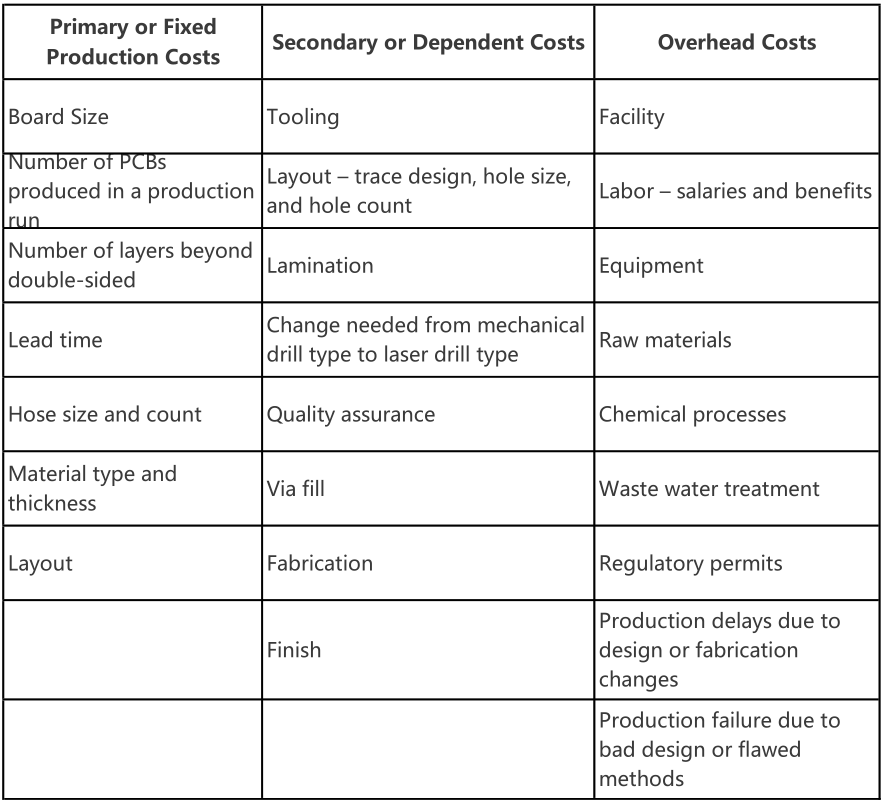
Layout alters the cost balance. While the number and size of holes remain the same with single-sided PCBs, two different circuit designs on one substrate change the number of holes and add vias.
Because double-sided PCBs welcome complex circuit designs, layout also becomes a dependent factor. As the number of traces increase, costs increase. Smaller surface mount components fastened to the bottom side change the trace spacing. As the space between the traces narrows, costs can jump 5 to 10 percent.
Different layouts may require different hole sizes and the use of laser rather than mechanical drills. Smaller hole sizes and larger hole counts drive the cost higher because of a change in the manufacturing process.
Advantages of Single Sided PCB
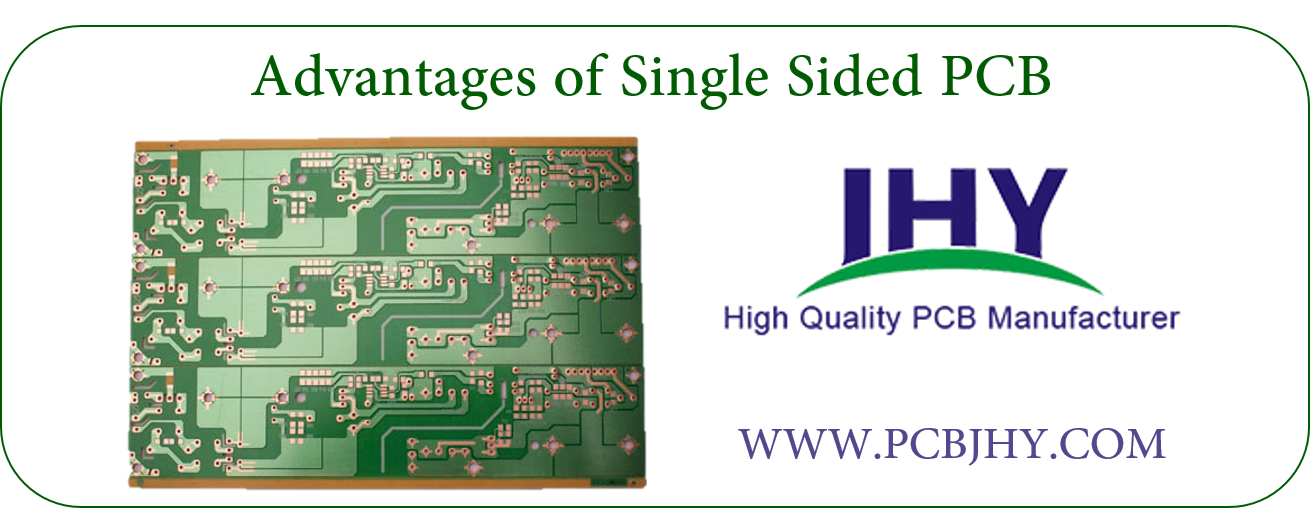
- Simple and easy to design and install
- Lower cost, especially for high volume orders
- Easy drilling, soldering, de-soldering and components inserting process
- Lower probability of manufacturing issues,such as short circuiting and producing noise
- Components are installed at only one side, require lower jumper to compensate the circuit
- Popular, common, and easily understood by most PCB manufacturers
- Less time for fault tracing and repairing
Single Layer PCB Disadvantages
Despite their cost advantages and other perks, single-layer boards are not the right choice for every project due to the limitations they have, which include:
- Simplistic Design: The simplicity of single-layer boards' is one of their biggest benefits, but it's also a substantial limitation. For more complex devices that require a higher number of components and connections, a single layer does not provide enough space or power. If wires cross each other, the device won't function properly, so it's critical that the board has enough space to accommodate everything. More complex designs just can't fit on single-sided PCBs.
- Slower Speed and Lower Operating Capacity: The limited number of connections on these boards also affects their power and speed. These less-dense designs are not as robust as those with more circuits and have a lower operating capacity. They might not have enough power for some applications.
- Larger Size and Higher Weight: To add capabilities to a single-sided board, you need to expand its dimensions rather than add another layer, as you could with you a multi-layer PCB. You could use multiple separate boards, but one multi-layer board could likely handle the same requirements. Increasing the size or number of boards in a device also increases your final product's weight.
How to make single sided PCB
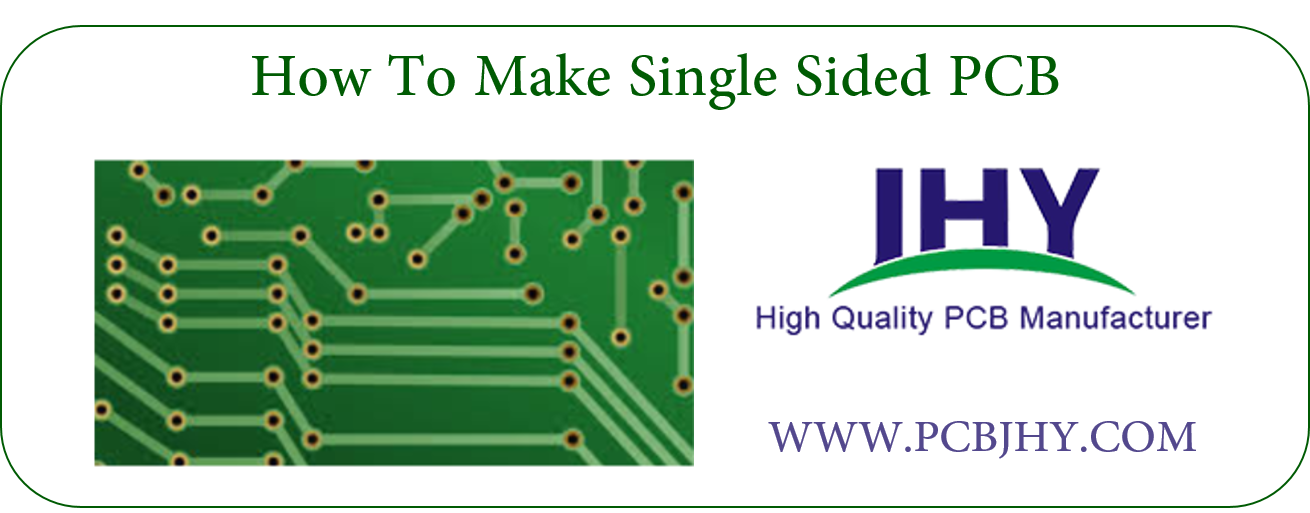
Single sided PCB manufacturing Process flow chart
One thin layer of thermally conductive but electrically insulating dielectric is laminated with copper. Soldermask is usually applied on top of the copper.
Cutting - Cleaning - Drilling - Cleaning - PTH - Panel - Plating - Cleaning - Photolithography - Image Transfer - Inspection - Copper/Tin - Plating - Coating - Removing/Etching/Tin - Removing - Inspection - Cleaning - Solder - Mask - Exposure/Develop/Inspection - Prepreg - Screen - HASL - Conformal - Coating - Post - Soldering - Cleaning - Test - Final Inspection - Packing
Single layer PCB Raw Material
- Fr4 Grade Fiberglass Laminates
- Aluminum
- Copper base
- Cem 1
- Cem 3
Construction of Single Sided PCB
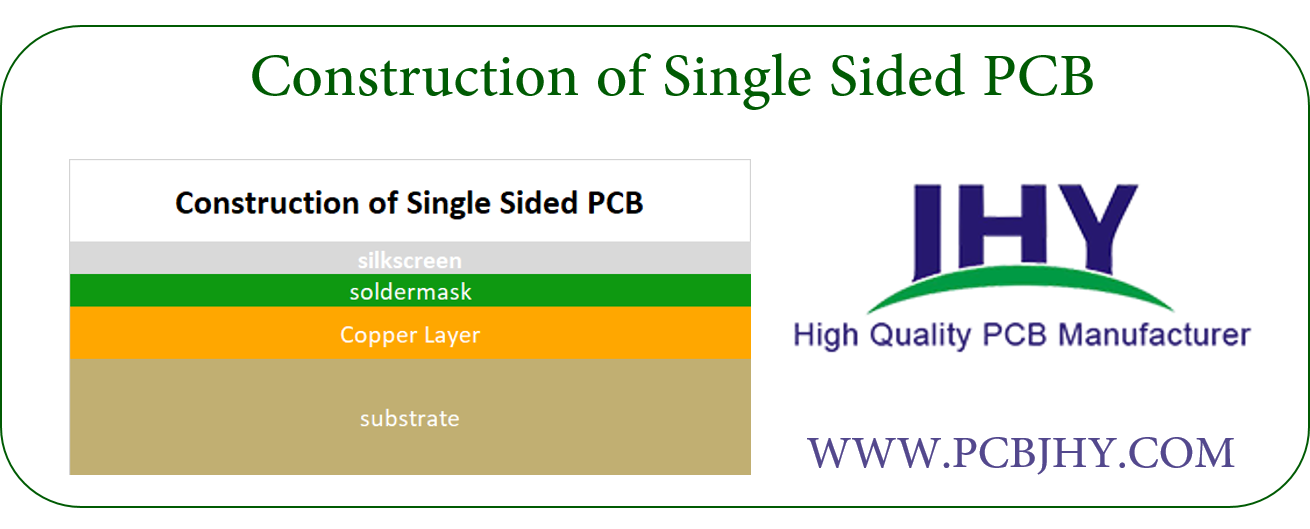
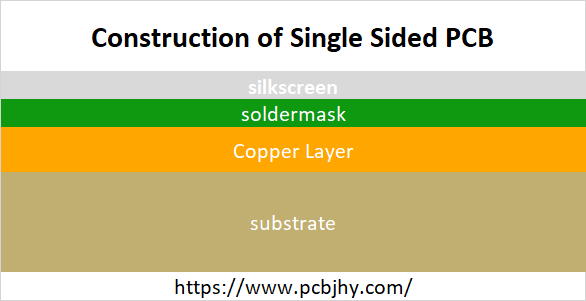
The base material, which is also named as substrate, is composed of insulating fiber glass which gives PCB strength and compact look. The nature and type of base material defines if board is going to be Flexible PCB or Rigid PCB.
Above substrate, there lies a copper layer which provides conducting path for various components on the board. The copper thickness is different for different boards depending on your needs and requirements and is defined in ounces per square foot.
On the top of copper foil, there exists a solder mask layer. This layer is mainly used for protection and makes the copper foil insulating which helps in avoiding the conduction in case direct contact happens with some conducting material.
On the top of all layers, there exists a silkscreen layer that is mainly used for adding symbols and characters on the board so a common person can anticipate the clear understanding of the board.
Single-Sided PCB Applications

- Vending machines
- Camera systems
- Surveillance
- Calculators
- Printers
- Solid state drives
- Coffee makers
- LED lighting
- Packaging equipment
- Sensor products
- Power supplies
- Relays
- Radio and stereo equipment
- Timing circuits
What Is Double-Sided PCB
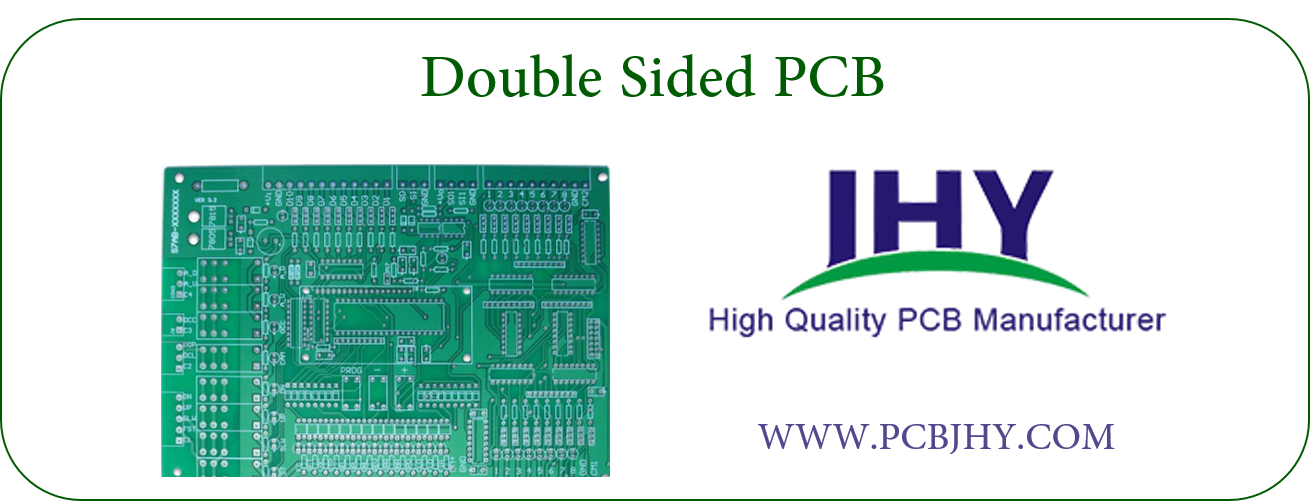
It need circuits on both sides. Via is the holes on boards, coated with metal and it can connect wires on both sides. Because the area of Double-sided PCB is twice as large as the Single-sided PCB, and because the wiring is interleaved, which is better suited for circuits that are more complex.
Someone may feel confused that if one Double-sided PCB, wires on both sides while Electronic parts only one side, is this a Double-sided board or a single onel? The answer is obvious. This kind of board is a Double-sided board, it's just install a component on the Double-sided board.
Differences Between Single sided PCB and Double sided PCB

single sided vs double sided PCB
Single and double sided printed circuit boards share the same material make-up: FR-4, which is a form of fiberglass mixed with epoxy. In modern manufacturing, this is usually layered with copper for conductivity and then coated in solder mask for a professional finish. Sometimes, in a process called silk screening, industrial printers print markings and labels on the board as well.
Single-sided PCBs consist of the FR4 insulating core substrate and a thin layer of copper coating on the bottom or solder-side of the substrate. Through-hole components mount on the top or component-side of the substrate with the leads passing through to the bottom side and soldered to the copper pads and tracks. Surface mount components mount directly to the solder side. The primary difference between the two boards will be in conductor placement.
Double-sided boards rely on the same core substrate but have conductors on both sides of the substrate. Very simply, a double-sided board delivers twice the area for conductors. Complex routing can occur with through-hole components mounted on the top layer and surface mount components mounted on the bottom layer. Plated through holes establish [vias" or the electrical connections between the two sides.
Choose Single Sided PCB or Double Sided PCB?
Which PCB you pick depends on your needs and requirements. Sometimes single sided PCBs are more suitable for project design as compared to double sided PCBs and vice versa.
Before you pick any type of PCB for your project, you must take one thing into consideration that single sided PCB layouts are more difficult to route as compared to double sided PCB, but following are the reasons why you should put an effort for making and picking single sided PCB over other PCBs.
- If you are hobbyist or students, and concerned to make PCB at home, you must know, developing single sided PCBs at home are much easier than developing double sided PCBs at home.
- As you are a manufacturer and very much interested to keep your cost down and producing a single sided PCB a most economical process. In terms of cost, producing single sided PCBs are more economical than producing double sided PCBs.
- Almost all HVAC systems make use of single sided PCBs, because they are more reliable and cost effective and don`t compromise the overall quality of the product.
- Using through hole technology in single sided PCBs still have its drawbacks and limitations because conductive layers, lines and pads stay on single side of PCB but it still is a cheap process to combine all components at one place. Multilayer PCB is also used in many applications where single sided and double sided PCBs fail to fulfill the requirements.
Relationship Resources
Multilayer Metal Core PCB
Single Layer Metal Core PCB
Single Sided Flexible PCB
Single Sided PCB
Single Sided PCB, Single Layer PCB, 1 Layer PCB, making circuit boards
JingHongYi PCB (HK) Co., Limited , https://www.pcbjhy.com